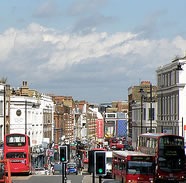Attributed to investment in 'green buses'
 Results from June to December last year show a major reduction in the number of times nitrogen dioxide levels on Putney High Street exceeded the EU hourly target.
Results from June to December last year show a major reduction in the number of times nitrogen dioxide levels on Putney High Street exceeded the EU hourly target.
A council monitoring station located close to the kerb recorded 42 per cent fewer pollution episodes in the second half of last year compared to the second half of 2012, 2011 and 2010.
At the side of the pavement furthest from the traffic the fall was 72 per cent.
A new report by King’s College London, commissioned by Wandsworth Council, confirms the reduction coincided with new technology being fitted to the exhaust systems of the local bus fleet.
The study ruled out other factors like weather conditions and changes in the number of vehicles. The drop was exceptionally high compared to other parts of London.
Despite the improvement, nitrogen dioxide levels still regularly breach the EU hourly target and more action is needed to bring them down.
Levels of fine particles (PM10) have been below the EU target throughout the four year testing period.
The King’s study is the latest phase of Wandsworth Council’s unique air quality project which ensured Putney was moved to the front of the queue for Transport for London’s (TfL) green bus investment.
The King’s report praises the council’s approach to monitoring air quality on the high street and recommends “extending the study method to other locations across the city.”
The council’s innovative technique uses number plate recognition cameras to analyse traffic and cross references the data with real-time air quality readings. It means the impacts of new emission reduction measures, like TfL’s bus retrofit programme, can be tracked in ‘real world’ conditions.
Cllr Jonathan Cook, Wandsworth Council's spokesman for the environment, said: “In 2011 we identified buses as the main source of pollution. This brought TfL to the table and put the high street in pole position for green bus investment. The King’s report now confirms this led to a major drop in pollution episodes which exceed EU targets. We are making progress here and we have to keep up the momentum.
“We now want TfL to continue to improve the bus fleet that travels along Putney High Street, by introducing ultra low emission busses, as well as zero emission electric or hydrogen models. This is a sensible next step in our combined efforts to tackle these pollution levels.
“The Putney High Street project provides a new blueprint for how we measure air quality around heavy traffic and analyse the success of new investment in cleaner vehicles. There is no longer any need to rely on manufacturers’ claims or projections – impacts can now be measured in real world conditions where we all live and breathe.
“We are also about to consult with high street businesses on new loading restrictions which will help to reduce the traffic jams which exacerbate pollution levels. This could make another significant contribution to protecting local residents’ health.”
2009 - 2014 1. In 2009 Wandsworth Council installed an air quality monitoring station on Putney High Street to develop an evidence base around the high street’s pollution issue. |
July 17, 2014